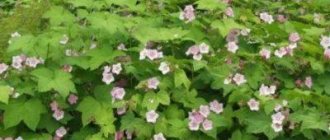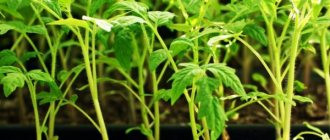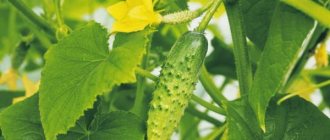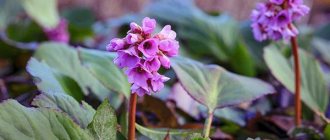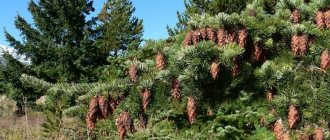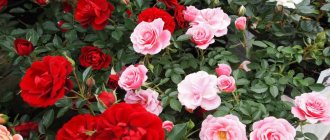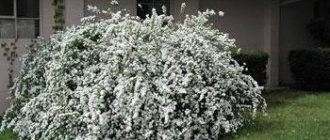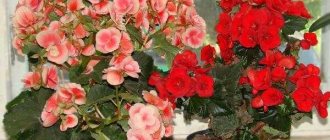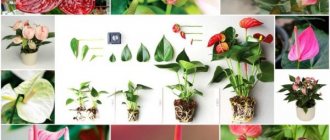Cypress pea Filifera Nana belongs to the Cypress family, and it is quite different from its “relatives” in appearance. The fluffy, evergreen shrub is famous for its resistance to bad weather, its ability to add zest to the site, and the fact that its spherical crown practically does not require additional shaping.
Cypress pea Filifera Nana
Important to know about Filifera Nana
Growing characteristics are a decisive factor when purchasing plants. It is important to know the following about Filifera Nana.
- Can be grown indoors and outdoors.
- Loves partial shade and sun.
- Sprinkler irrigation should be used as an additional irrigation method.
- Perennial. Classified as a coniferous plant.
- Frost resistance - level 5 on the USDA scale.
- Immune protection against pine beetle, spider mites, and scale insects is poorly developed.
- The maximum height of the bush is 50 m. The crown width is 80 cm.
- Blooms in early May. Cone fruits appear in October.
- Reproduction is possible by cuttings, sprouting from seeds, and grafting.
- There are several varieties. The main difference is the color of the needles and height (there are miniature species, with a dark green crown, blue-green, with a light green tint).
- The plant needs fertile, sandy or loamy soil. Does not take root on calcareous soils.
- Suitable soil acidity is pH 4.5–5.5.
- Life expectancy is up to 300 years.
This plant lives incredibly long - with proper care, up to 300 years.
Important! If the basic criteria seem acceptable to you, you can enjoy growing the perfect coniferous bush.
Cypress pea Filifera Nana (Chamaecyparis pisifera Filifera Nana)
Cypress trees are one of the most decorative of coniferous plants, although they require attention and care. Growing on the Japanese islands, they need high air humidity and do not always withstand winter cold. All the work pays off with a beautiful crown shape and bright shades of pine needles.
Cypress Filifera is a compact, slow-growing species that can be grown in a container and kept indoors for the winter. In regions with mild winters, perennials can be safely grown in open ground.
Description of the variety
Cypress pea Filifera Nana is one of the few dwarf representatives of this species of coniferous plants. In adulthood, the bush reaches a height of 40–50 cm; the plant can spread 100–120 cm in diameter. Ephedra grows very slowly, increasing in size by 5–6 cm per year.
The shape of the cypress bush Filifera Nana is close to cushion-shaped and weeping. Numerous branches stretch upward from the short trunk, then fall down. The shoots are cord-like, covered with scaly short needles. The color of the needles is emerald, with barely noticeable white streaks.
Every year, many small brown cones ripen on the plant, which contrast effectively with the green delicate needles.
On a note! The variety is propagated only by cuttings.
The perennial creates the impression of airiness and tenderness. It looks impressive in a single composition on the lawn or in a rocky garden. to the company of the cypress 'Filifera Nana ' :
- conifers with a different needle structure and needle structure (spruce, columnar thuja, juniper);
- heathers;
- bright low-growing flowers (pansies, flax, marigolds).
In landscape design, conifers are actively used in Japanese and Chinese styles of site design.
The variety is photophilous and does not tolerate drying out of the soil and air. Needs feeding several times a season. Frost resistance is average, freezes at temperatures below -25 degrees.
Planted in a flowerpot, cypress feels great in a limited space. A container with ephedra can be moved around the site, creating new plant compositions.
Rules for planting and care
Pea cypress 'Filifera Nana' is planted in the spring, in April–May. For it, areas are chosen in the lacy shade of trees or near buildings so that during the midday heat the conifer is in the shade. Soils suitable for the plant are well-drained, fertile, with an acidity level of 5–5.5 units. Alkaline soils are acidified by adding peat and pine litter. Places where spring moisture accumulates should be avoided.
You need to put drainage in the planting hole - a layer of broken brick or crushed stone, a layer of 10–15 cm. When planting a seedling, you should add fertilizer:
- well-rotted manure or compost;
- mineral fertilizer recommended for coniferous plants (Pokon, Fertika, Buyskoye).
Cypress is planted without destroying the earthen ball, using the transshipment method. The root collar must remain on the soil surface, otherwise the plant will die.
After planting, the conifers are watered and the soil is mulched with tree bark, shavings, peat, and fallen needles.
Important! In order for the seedlings to take root well in a new place, they must not only be watered regularly, but also the crown must be sprayed with cool water. This should be done in the evening or on a cloudy day.
An adult cypress tree is watered at least once a week, preventing the top layer of soil from drying out. The roots of the plant are superficial, unable to extract moisture from the lower layers of the soil. Irrigating the crown with water is beneficial for plants if the weather is rainless.
The plant is fed 2-3 times per season, adding mineral fertilizers and micronutrient complexes. The first feeding is given in April, when the ground has thawed and warmed up. They finish fertilizing the perennial in July so that the plant has time to absorb all the elements and prepare for winter.
Pea cypress overwintering in open ground should be covered in October–November. Mulch from wood shavings is added to the trunk. Strong arcs made of metal rods or a frame of wooden bars are installed above the bush. The structure is covered from above with several layers of lutrasil, agrospan or burlap. Covering film is not suitable, as it does not allow air to pass through, and the plant may rot under such cover.
Every spring, the cypress tree is trimmed, removing broken and frozen branches. The Filifera Nana variety does not need shaping.
Ephedra are protected from diseases by carrying out preventive spraying with drugs: fungicides (Rakurs, HOM). The likelihood of an outbreak of fungal diseases increases in cold and rainy summers, with excessive fertilizing with nitrogen fertilizers.
Cypress trees can be bothered by scale insects, moths, spider mites, and aphids. Pests are destroyed with insecticidal and acaricidal preparations: Inta-Vir, Fitaverm, Aktara, Topaz.
Botanical features
In botanical catalogs, this plant can be found under the name Chamaecyparis pisifera Filifera Nana. This is a bush with a woody trunk, many side branches, and a lush cone-shaped crown. The branches are covered with needle-shaped leaves of a pleasant dark green hue. The bark is reddish-brown, lighter on the lateral branches. The branches grow horizontally in the first year, then gravitate towards the soil - creating the illusion of a fountain or fan.
Flowering is barely noticeable - white petal scales appear on the needles. The inflorescence is spike-shaped. Filifera Nana seems to be covered with frost. Then the fruits ripen - small dark-colored beads-cones. Seeds form in them and are immediately dispersed by the wind.
They love cypress not at all for its flowering, but for its magnificent evergreen appearance, which decorates the garden at any time of the year.
Description of the oriental thuja
Thuja orientalis (flatweed) belongs to the cypress family, its natural habitat is the territory of Northern China. The plant is a record holder among long-livers, and can live for a whole millennium. On average, an adult tree grows up to 15–20 m, and some members of the family up to 35 m, and the crown diameter is up to 14 m.
A feature of the oriental thuja is its slow growth, which has both positive and negative sides. The plant can be used in areas with low buildings; it will not block the sun. Allows for infrequent pruning.
The young tree has a pyramidal crown shape, which over the course of several years becomes more rounded, closer to columnar. The cones of such a thuja look interesting - at first (in September) they are light green, plump, with hook-shaped growths; ripening occurs the following year: March, April - pollination, October - seed ripening. By this time, the cones become brown and the seeds look like grains of wheat.
Choosing a landing site
In Japan, where cypress trees are common, at one time breeders managed to breed miniature specimens. Other varieties may one day destroy the ceiling. These are not uncommon on the island of Hyunshu - even 30-meter representatives of the family can be found. The classic Chamaecyparis pisifera Filifera Nana grows to about 50 cm in 10 years, and Chamaecyparis pisifera Filifera Sungold grows to a height of up to 1 m in the same number of years.
Chamaecyparis pisifera Filifera Nana feels great near the porch, in the flowerbed. It needs a little shade, so when growing outdoors, it is better to choose an area near the house or trees nearby. It does not tolerate strong and absolute shadow and begins to fade.
Important! When growing it indoors, you should use Bio lamps so that photosynthesis and other processes proceed at a normal, natural pace. The light from an ordinary light bulb, one or several, is not enough. Artificial lighting is very different from sunlight in intensity and other indicators.
Filifera Nana grows, as a rule, only up to half a meter in height.
Filifera Nana is valued not only for its “appearance”, but also for its ability to produce phytoncides in large quantities compared to other species. And pine, for example, synthesizes from 0.2 to 13 mg of phytoncides per hour, and indoor lily - tens of times less. These substances are different, their properties are currently being actively studied. The discovery was made not so long ago - in 1928.
These substances, to one degree or another, have a detrimental effect on viruses, fungal spores, help the plant itself overcome the disease or prevent it, and everyone who is nearby. Therefore, it is useful to have a coniferous plant - for example, Filifera Nana.
Air humidity and proper watering
Increased and decreased levels of air humidity are negative factors for Philifer Nana. Cypress pea fruit loves moderation. It is watered two to three times a week, and each time the branches are sprayed with water using a spray bottle or a special hose attachment. This way you can wash off the dust and ensure the sprouts are hydrated. When growing indoors, you should pour a little water into the tray under the pot. In hot weather, watering must be carefully controlled. To save money, you should resort to root watering.
Water the pea cypress 2-3 times a week, and in the summer it is recommended to periodically spray it with warm water using a hose or spray bottle
Care
Cypress, like all conifers, is not too demanding to care for. But you will still need to complete individual activities.
Plant care should consist of:
- regular irrigation;
- application of fertilizers;
- disease prevention.
Important! Plants experience stress if they are watered with cold and chlorinated water. Therefore, when watering potted forms of cypasis, be sure to settle the water.
Watering and fertilizing
The soil should remain evenly moist. Therefore, summer watering is performed 1–2 times a week. It should also not be over-moistened. The plant can only tolerate slight drought. Therefore, irrigate if the top 5 cm are dry and you cannot feel the moisture on it with your fingers.
The plant needs fertilizer in early spring. This affects the intensity of the color of the needles and its thickness. The young seedling is fed with a balanced fertilizer. It should contain nitrogen, phosphorus and potassium in equal proportions. For example, 10-10-10. Rooted plants require a different proportion. So, if you do not want to set records for annual growth, buy fertilizer with a reduced proportion of nitrogen. For example, 4-8-8. For the same reason, you cannot fertilize cypress trees with rotted manure - it contains too much nitrogen.
Loosening and mulching
Loosening the garden is necessary for two reasons:
- weed removal;
- soil aeration.
Air in the soil is needed to support the development of beneficial microorganisms. They process those compounds that bushes are not able to absorb on their own. For example, phosphorus in the form in which it is found in fertilizers is not absorbed. It needs to be processed and this requires soil bacteria.
On average, the plant will consume only 15% of the amount of phosphorus you added this year in the same period. As for weeds, they compete with cultivated plants for nutrients and moisture. To eliminate this competition, weeds must be removed.
Loosen the soil a day after watering. But if a layer of mulch is placed in the root zone, then this is not necessary. It prevents the soil from compacting, preventing weed growth and moisture evaporation. Choose organic mulch for coniferous crops: wood chips, chopped straw or sawdust. Under the influence of irrigation water, it will become compacted and crushed. It will have to be topped up monthly. And after six months, replace it. When exposed to moisture, mulch releases the nutrients it contains to the soil. And after a while it still performs its main function, but no longer feeds the bush.
Trimming
Shrubs are not recommended to be pruned unless absolutely necessary. They do not tolerate pruning well and are slow to recover. But tree-like varieties, such as Boulevard, lend themselves well to pruning. It can be given shape, but this must be done in the first years after planting, and then simply maintain it, annually removing those branches that deform the given shape.
Video: Trimming a cypress tree
Also, any plant periodically requires sanitary pruning - removal of dry branches. They are cut carefully at an angle of 90 degrees to the trunk. Avoid breaking them as this can cause disease and damage the rest of the bush. Dry branches are pruned when they are discovered, without regard to timing. Pinching is also used for cypress. This is necessary for branching. Some shoots may be unevenly greened. Pinching stimulates the growth of “dormant” buds and will help restore the needles.
Important! Never remove more than 1/3 of the green mass from a plant. This could cause his death.
Possible diseases and pests
All cypress trees, being healthy and growing on fertile soil, suffer little illness. The most common cause of disease is excess moisture. Therefore, the gardener must adhere to the rules of irrigation. If necessary, when planting, place a drainage layer up to 20 cm thick at the bottom of the hole. It minimizes contact of the roots with water.
Main problems and their solutions:
| Problem | Solution |
| Needles fall off on lower branches | This is not a disease, but a property of the plant. It cannot be prevented. Such branches are simply cut off. |
| The needles turn brown | This is a lack of moisture. The decrease in humidity during the hot summer months sometimes causes the needles to turn brown. Just water thoroughly. |
| Needles turn yellow | This is a weevil. Adults are brown beetles with long snouts. Their larvae are found in the soil. Spray the tree and soil with Kinmiks (2.5 ml per bucket of water) or Decis in the same proportion of the working solution. |
| Yellow or cream scales on branches | This is a scale insect. Wipe the stem with a cotton pad soaked in kerosene. The use of oil sprays is no less effective. |
| Sticky web on needles | Spider mite. Treat with Fitoferm, Actellik, Zolon or another preparation. |
Fertilizers and soil type
Planting plants together with the soil in which they were germinated is becoming an increasingly popular technique. The advantages are:
- the ability to protect plants with sensitive root systems from stress;
- it is impossible to disrupt nutrition when there are special requirements for the soil and the seedling does not have a very massive root system.
In the case of pea cypress, the method is also relevant. This will speed up adaptation. But you will still have to form a drainage layer at the bottom of the planting hole. Filifera Nana requires chernozem or loam mixed with sand to grow. Sandy loam soil is slightly less suitable. Calcareous soil is the worst option.
Important! It cannot be grown in places where melted snow accumulates in the spring or where groundwater is located close to the surface.
The Filifera Nana variety is quite demanding on the soil - for example, calcareous, sandy loam soil is not particularly suitable for it, but chernozem is just right.
Fertilizers are used with nitrogen. This element is very important for Philifer Nana. If there is a lack of it, signs of wilting will appear. Nitrogen is contained in chlorophyll, which, in turn, is contained in leaves. In Filifera Nana, the accumulation of nitrogen and the synthesis of chlorophyll occurs in a special way, unlike in deciduous shrub crops. If there is a lack of it in the soil, an ordinary flower will experience stress, but will still be able to wait for bait. But Philifer Nana is not there. Negative changes will be immediately observed, and if the situation does not change soon, the plant will die.
Phosphorus is important. It is needed for growth, and in addition, for the formation of ovaries, fruits, and seeds. It is necessary to use phosphorus-containing mixtures in the summer, and nitrogen-containing mixtures in the spring. In the fall, when the sap circulates more and more slowly in the branches, it is necessary to fertilize the soil with fertilizer containing potassium. This element will protect the sprouts in the cold and allow the bush to quickly recover. It increases the osmotic pressure inside the cells, at the same time accelerates the accumulation of nutrients in the roots, promotes the thickening of cell membranes, and improves the synthesis of carbohydrates. The plant is in a state of vegetative dormancy, but the root system continues to absorb nutrients from the soil. True, this happens much more slowly. But among natural fertilizers, compost, overripe humus, is suitable.
With a lack of nitrogen, phosphorus, and potassium, plants can become very sick
As an additional method of soil care and providing plant nutrition, a technique such as mulching can be used. It protects the earth from drying out and weathering of useful substances.
| Experts recommend using the following mulch options: | mown grass; sawdust; leaves; nutshell; peat; expanded clay |
A negative reaction may be observed to classic pine mulch, as well as to related species growing too closely. In addition, pine needles can disrupt the harmony of the landscape, as if hinting at the withering of Philifer Nana to others.
Important! This option is the least suitable.
Sawdust, peat, and expanded clay can be used as mulch for cypress trees.
Features of growing cypress pea in the Moscow region
In order for the plant to take root and develop well, the planting hole for pea cypress begins in the first half of October. For this:
- The soil is dug to a depth of 90 cm. Holes are made at a distance of 1 to 4 m, depending on the plant variety.
- The bottom of the planting hole is covered with a 15 cm layer of drainage.
- The next stage is laying the fertilizer. To do this, combine peat, turf soil, sand and humus in a ratio of 2:3:1:3. The top layer of soil is introduced into the prepared mixture and everything is thoroughly mixed.
- The dug holes are covered with protective material to create a favorable microclimate. In the spring, the fertilizer will rot, and the earth will be ready to accept the young plant.
- In the spring, the hole is watered and the root system of the seedling is straightened.
- The prepared planting material is placed in the center of the hole and 300 g of nitroammophoska is added.
- The roots are covered with soil, compacting each layer.
- The soil is watered generously and mulched.
Advice! Tall specimens are tied to a peg during planting.
Where can I get a seedling of Filifera Nana?
New seedlings can be purchased at a florist shop, nursery, or you can germinate a new bush - from a branch of Philifera Nana, cones - and then plant it in the ground. If one specimen has already grown before, you can graft the cuttings.
Sprouting from seeds is considered the most convenient way to propagate this plant. Branches do not always take root due to the characteristics of life and biological properties, and grafting a bush requires careful preliminary comparison of varietal characteristics. They may later become unstable and not appear at all.
The degree of germination of seed material is also a variable indicator and depends on many factors. However, the likelihood that strong seedlings will be grown is higher in this case than in the case of grafting or cuttings.
Important! From the point of view of the biological characteristics of the plant, the seed propagation method is the most natural and dominant.
It is recommended to propagate cypress trees from seeds, but this method is quite long and requires patience.
To germinate Philifer Nana from seeds, you need to prepare a mixture of sand, black soil, peat, place them in a weak solution of manganese, then for a day - in water or melted snow (they are germinated in the fall, after collection or in the spring, after stratification). A gibberellin solution will help increase germination rates. The seeds are placed in it for 20-30 minutes before planting.
Having placed 2 seeds in a container with soil, you should pour a layer of earth 1-2 mm thick on top. Cover with film and place in a warm, well-lit place. Shoots will appear in a few weeks. It happens that seeds germinate only after a couple of months, and sometimes only after a year, but these are very rare cases.
Important! Stratification and gibberellin are the main methods of activating growth in the shortest possible time.
Taking into account these characteristics of reproduction, it is easy to come to the conclusion: the easiest way is to purchase seedlings grown by specialists. Skill and strict adherence to the rules of agricultural technology allow them to easily grow plants from seeds with stable varietal characteristics. Independent work is always an experiment. The biological processes in the seed are complex. Incredible sensitivity to the environment, type of soil, air temperature, level of nutrients accumulated during ripening - all this makes the result unpredictable. All efforts may be in vain, time and money will be wasted.
You can purchase seedlings that have already been grown from seeds by specialists, but this should only be done in nurseries or stores
Planting and care
The soil
Both the appearance of the tree and its growth rate directly depend on soil conditions. The plant prefers loose, moderately moist soil. It is ideal if you plant the cypress tree in loam, as this soil holds moisture better. It is advisable to plant cypress in well-drained soil. Under no circumstances should the plant be planted in calcareous soil, as in this case it will not develop well.
Site selection
This plant prefers open areas or light partial shade. It is very undesirable to plant a tree in areas in lowlands, with close groundwater or with stagnant water. It is ideal if you plant the cypress tree in a moderately lit area where melt water does not linger in the spring.
Selection of seedlings
A healthy and strong seedling is the key to successful cultivation of cypress. You cannot buy a seedling whose roots are exposed. The fact is that all conifers cannot tolerate drying out their roots, and a young plant may simply die after planting.
It is advisable to purchase planting material from nurseries. This way you will be sure that you bought the variety you needed and that the seedling is healthy. Turn over the container with the seedling - if the soil does not crumble, but falls out in one lump, then the plant was planted a long time ago. You should not buy a seedling that has recently been planted in a container. Be sure to inspect the young plant - the tips of the needles should have no signs of drying out, be fresh and lush green.
How to identify strong seedlings?
A plant with strong immunity that easily adapts to new conditions can be selected in a store, nursery, or among seedlings on a windowsill based on the following criteria.
Is the root system in the pot closed or open?
Pea cypress does not tolerate lack of soil. Bare roots are not for him. When germinating seeds, a small layer of soil mixture helps to guide the stem upward in a timely manner. The seeds seem to turn themselves, focusing on where the air comes from, the temperature of the soil, the distribution of heat and the thickness of the top layer, its density.
Important! If the purchased plant has had its roots open for a long time, you should give preference to another, or when replanting, leave a small space first for mulch and then for soil.
Branch color
The branches grow, becoming woody at the base - only their top contains growth hormones in large quantities. Therefore, the gardener, by cutting them, has the opportunity to slow down the growth of the entire plant. Sometimes cutting off the top is dangerous - the whole bush can die. If the branches are yellowed, there are many of them - more than green ones - the color of not only the lower tier has changed, it is undesirable to purchase such a plant. There is a high probability of his death in new conditions. It needs additional care, feeding or changing the intensity of lighting and watering. Additional time will be spent preparing for the transplant, and a beginner may not be able to cope with this.
You should not purchase seedlings with yellowed branches - the plant will most likely die in new conditions
Earth clod density
Very dense, stone soil in a pot indicates a violation of the rules of agricultural technology. In the future, all the mistakes of the nursery or store employees who looked after it may remind themselves - the plant will be painful, capricious, and demanding. The lump of earth should be of medium density.
Of course, after more careful care is provided, the seedling will recover and literally in a year will become truly strong, beautiful, and well-groomed. But the first season you will have to tinker with it. It is strictly not recommended to purchase only a diseased plant. In all other cases, the new owner can restore balance and restore harmony. The main thing is not to regret the purchase.
Of course, it is not recommended to purchase a diseased plant. It may be possible to cure him, but it will take a lot of effort.
Diseases and pests
The dull ephedra Nana Gracilis has a strong immune system. The only insects that can damage the crop are scale insects and spider mites.
The affected plant dries out, loses its needles, and dies. When a tick appears, the bush turns yellow and the needles fall off.
The insecticide Nuprid is effective against pests and is treated in several stages at intervals of a week. Acaricides can also be used against ticks.
The most common disease is root rot. It appears due to illiterate care, waterlogging of the soil, and lack of drainage.
At an advanced stage, the conifers are destroyed, but at the initial stage, seedlings can still be saved. They are dug up, rotten sections of the roots are cut off, healthy ones are treated with a fungicide.
The treated roots need to be left in the air for a while to dry, and the surface of the wounds should be sprinkled with charcoal. Then the plants are transplanted to a new location.
Landing rules
The decorative characteristics of Filifera Nana allow you to plant bushes one by one or in a group. It is suitable for creating a green cascade on an alpine hill and looks great against the backdrop of natural and decorative stone.
This plant from Asia can be chosen when creating a Japanese-style landscape. Its exquisite crown allows you to hide the fact of the absence of a gardener and create a design in a classic palace style.
The Philifera Nana cypress looks great on the alpine hills, against the backdrop of stones
When changing the landscape design, you first have to draw up a plan diagram indicating the variety and the expected location of growth. This is not done when updating, making changes, or making spontaneous decisions. In both cases, when choosing Philifer Nana, you should remember these nuances.
- The minimum distance between bushes should be 1 meter.
- The depth of the planting hole should be about 90 cm.
- The hole is dug a few days before the start of planting work so that it warms up, or it is watered with hot water and work begins after a few hours.
- A drainage layer approximately 10-15 cm thick should be formed at the bottom.
- On top of the drainage layer it is necessary to form a nutrient layer of humus, peat, sand, and chernozem.
- It is undesirable to destroy the clod of earth in which the seedling previously grew.
- After planting the bush, water it, lightly compact the soil, and apply mineral fertilizer.
When the plant has been planted, it needs to be watered abundantly
- The final stage of planting work, very important for protecting the root system from soil shrinkage, weathering, and death, is mulching. A layer of mulch up to 7 cm thick is insurance against this.
- The root collar should not be located very deep.
- After replanting, you need to water and spray the bush every two days for several weeks, that is, more often than an adult plant. It is advisable to install a small canopy - a little shade will not hurt at first.
Important! Planting young bushes, therefore, does not take much time and differs slightly from the standard plant transplantation algorithm. But due to the requirements for the depth of the planting hole and the distance between seedlings, difficulties may arise.
It is important to maintain a distance between plants so that they do not interfere with each other
Rules for planting pea cypress
To achieve the expected result from planting cypress pea, you need to choose the right place and plant.
Pea cypress grows well and develops in a bright place, where strong, cold winds will not reach it. The soil on the site should be nutritious and well-drained.
When planting several bushes, it is necessary to maintain an interval of at least 1 m, since the root system develops horizontally.
How to plant a plant correctly:
- Prepare a light nutrient soil. This can be humus or purchased soil intended for coniferous crops.
- Dig a hole, the depth of which should correspond to the size of the root system.
- Place the seedling in the center of the planting hole and begin to fill it with prepared soil, compacting each layer so that no air cushion occurs.
- The earth is watered and mulched.
Important! The root collar should rise 10 cm above the ground surface.
During the winter season
With the onset of cold weather, the above-ground part of Philifer Nana, of course, is not cut off. It grows very slowly and, most likely, will not be able to recover after this. At the same time, its resistance to frost is relatively high - 5 points on the USDA scale.
This scale was created specifically to make it easy to buy the plants you need. It is also convenient for breeders to select the necessary hybrids for crossing, in accordance with the required parameters. Zone 5, to which the Filifera Nana variety is classified, is plants that survive when the air temperature drops from -23 to -26.
Important! Wrapping a cypress tree in film for the winter will still not be a bad idea.
Cypress is a frost-resistant plant, but just in case it can be covered for the winter.
Many gardeners recognize the following as the optimal technique for covering Filifera Nana for the winter:
- the branches of the plant are neatly tied;
- mulch is poured, spruce branches are laid on the soil and the lower tier of branches;
- the crown is wrapped with film;
- in March-April, remove all elements of the shelter, remove frozen branches, if there are any, of course.
This will take about 30-40 minutes. If many such cypress trees are grown at the same time, this precaution should still not be neglected. The disadvantage of this method is that the shelter may become unstable to gusts of wind due to changes in the position of the branches. When it comes to an alpine slide, stability is a priority factor. It is better to install a mini-greenhouse - dig a metal frame around the perimeter, stretch the film and secure it with bricks and earth. This technique is, of course, more complex and time-consuming, but this way you can take care of several plants at once.
The trunk circle of the plant can be covered with spruce branches, as well as the lower tier of branches
Interesting! Cypress pea Filifera Nana, according to some people, has magical properties. It is used in feng shui to protect against the evil eye and damage. To do this, it is placed on the window sill of the window located opposite the entrance door to the room. It is better to place a compact indoor fountain next to it. Filifera nana, like all life on the planet, is a source of energy, absorbs carbon dioxide, produces phytoncides, and changes the atmosphere around it.
Popular varieties of cypress
The most popular varieties in gardening are such varieties as Boulevard, Squarrosa, Filifera sun gold. Boulevard's foliage has a pleasant blue-blue tint with a silvery tint. The crown is conical and lush. The bark is red-brown. This color contrast helps relieve tension from the vision receptors after a busy day, at the moment of fatigue, and adds strength. The height of an adult plant is 2 meters. The disadvantage is that the plant is poisonous.
Squarrosa has slightly curved needles of a bluish-green color. This makes the cone-shaped crown more expressive. In autumn, the color of the bush changes, the needles turn brown. Does not tolerate drought well. It grows up to 10 m in height, but within a few decades. Sangold grows not so slowly. Its maximum height is 1 meter. The crown is juicy green, up to 2 meters in diameter, cone-shaped.
A relative of Philifer Nana is the Boulevard cypress, which can be planted nearby
Description of culture
Cypress obtuse Nana Gratsilis is:
- perennial;
- evergreen;
- coniferous culture.
It has been used in the field of gardening and landscape design since the 18th century, first appearing in Japan. There it is more common in mountains and areas of high humidity.
On average, Cypress grows up to 5 meters, although in an ordinary garden it often reaches 2-3 meters, while its width grows to 1.5-2 meters. What is characteristic is that the plant will not become like this very soon, because it is characterized by rather slow growth. So, by the age of 10 it will stretch only 50 cm.
The tree is also distinguished by the shape of the crown, which is very wide, and moreover, it is not very regular. It takes the form of a cone or can be asymmetrical. There are also:
- ovoid;
- widely cone-shaped.
The crown of the plant is formed by short branches located very closely. They are covered with smooth reddish-brown bark. Their wavy-twisted configuration makes them resemble swirling shells.
At the end of summer or with the onset of autumn cold weather, cones form on the branches. Inside they have only 2 winged seeds.
This effect is largely achieved due to the dense arrangement of needles on the branches; they are shiny, so soft to the touch, 1.5-2 cm long. Its shade can vary from dark green to light green. The color changes depending on where the crop is grown.
The root system of a tree has its own characteristics:
- power;
- strong branching.
The roots are located in the upper part of the soil.
In landscape design
Since the Filifera Nana variety has a short “growth”, it is usually used for rock gardens and mixborders. You can also make hedges and borders with the help of such plants.
In addition, cypress is an excellent background for other plants, because it remains green all year round. Also, this plant is ideal for those who do not like thorny conifers - Filifera Nana has soft needles.
Important! Such a plant looks great either planted separately, for example, at the entrance to a house, gazebo, or surrounded by its “brethren,” forming a green corner.
The pea cypress Filifera Nana looks good, even when planted alone.
When choosing the pea cypress Filifera Nana for your home, cottage, yard, or the area adjacent to the office, you should remember that this plant requires attention. It is easy to care for, but you can skip watering in the heat and it will wither, do not cover the roots thoroughly, or forget about frosts. With proper care for such a beautiful conifer, it will delight the eye for many years.

